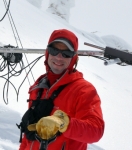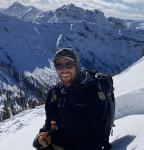We are wrapping up our 27th year of operation after issuing 138 avalanche advisories. Less snow in the northern mountains (87% of average) contrasted with the southern ranges where up to 117% of average snowpack was measured.
Blog List

Backcountry skiing and snowmobiling has exploded in popularity over the past 10 years. Every winter more skiers and riders hit the backcountry in pursuit of steep faces and untracked powder. This type of riding has increased the inherent risk of being caught in an avalanche and on average, 30 people die in avalanches every year in the United States.

Our job at the avalanche center is to warn and inform the public about the snowpack and avalanche danger. Unfortunately, the best information cannot prevent all avalanche accidents and deaths will remain a part of winter recreation. Montana has a million people, one of the least populated states, but in the last 15 years we are ranked second in the nation in avalanche fatalities and first in snowmobiler fatalities. These are not standings I am proud of: less people, more fatalities. Not a tag-line for the Montana Office of Tourism.

Avalanches involving people don’t happen randomly. 90% of avalanche incidents are triggered by the victim or someone in their party. In order to play safely in avalanche terrain we need to understand what’s happening with the snow.

Home of the Karakorum, Hindu Kush and Pamir mountains, Central Asia has a serious avalanche hazard. Mountain communities throughout Pakistan, Afghanistan and Tajikistan experienced a widespread avalanche cycle in March 2012 and again in February 2015 that destroyed villages, killed livestock and took the lives of hundreds of residents.

The Pit Stop - Dig and Communicate
Snow ties the backcountry community together, sometimes it ties us to avalanches. Taking the time to dig a snowpit and assess snow stability provides valuable information and generates conversation between group members. Good communication leads to better decision making in avalanche terrain.

When venturing into the backcountry, answering these two questions is essential when assessing a slope to ride:
Is the terrain capable of producing an avalanche?
-and-
Can the snow slide?
Avalanches happen when four ingredients are present: a slab, a weak layer, a trigger and a slope steep enough to slide. A key problem when assessing slope angle is that most slopes have varying degrees of steepness. It is critical for riders to assess slope angle frequently.

By Doug Chabot, Mark Kahrl and James Earl
ABSTRACT: SnowPilot (www.snowpilot.org) is open-source, free software that allows users to graph,
record and database snowpit information. New for this year is an online version of SnowPilot.

By Ian Hoyer, Ethan Green, Doug Chabot, Karl W. Birkeland
ABSTRACT: Knowing the Extended Column Test’s (ECT’s) effectiveness at different slab thicknesses is critically important for practitioners. To better understand the limitations of the ECT, we used the SnowPilot dataset to investigate the utility of ECTs for providing an index of crack initiation and propaga-tion on varying weak layer depths. The database currently contains 5013 ECTs conducted by 386, pri-marily professional, users worldwide between 2007 and 2016. The broad range of observers and snowpacks in the dataset allow us to examine variations in ECT results with changing weak layer depth across seasons and locations.

Every year we teach almost 100 avalanche classes to nearly 5,000 people across a wide swath of the recreating public: grade school and graduate students, skiers, snowmobilers, ice climbers, search and rescue groups, and ski patrols. Though the groups are diverse, the questions are similar. Here’s some answers the most common ones.

In 2002 Karl Birkeland was researching a new stability test, the Stuffblock, and needed willing participants to try it and record their data. Since Karl sits in the cubicle next to me, I was an easy recruit. All that season I filled a stuff sack with ten pounds of snow and dropped it from ever increasing heights, dutifully recording the results in my yellow Rite-in-the-Rain book along with other pit information. It was a relatively easy task.

Greetings:
The Gallatin National Forest Avalanche Center just wrapped up 26 years of operation. We started the season with the threat of a dry El Nino winter which never materialized and finished with a snowpack measuring close to 100% average. March got almost as much snow as January and February combined.

by Alex Marienthal
Spring is here with longer days and a more predictable snowpack to facilitate objectives that are steeper and farther. These objectives are possible while maintaining a personally acceptable level of avalanche risk. However, these objectives can mean more exposure to other hazards like exposed terrain and prolonged rescue, which increases the consequences of relatively small accidents. The snowpack structure is changing from cold, dry layers to warm, wet and icy layers. This transition creates a fresh mix of avalanche problems.

Spring riding can be some of the best of the season. Good snow coverage, warmer weather and more predictable snow stability (at times) can lead to unmatched riding conditions. Riding ability also improves after a full season which allows riders to push the envelope in avalanche terrain. While spring riding can be the best, it can also hold avalanche hazards not encountered during the colder parts of winter.

There were 15 avalanche fatalities in the western United States in January, 2016, the deadliest January in over 20 years. Five of the fatalities were snowmobilers, one was a snowbiker, six were skiers, two were snowboarders and one was a climber. Avalanches are an equal opportunity killer and do not discriminate. To avoid becoming a statistic follow three simple rules of backcountry travel and learn to manage terrain and snowpack carefully.

The snowpack is a record of weather events that take place during the winter. Heavy snows, wind, even long dry spells, help to create unique layers in the snowpack. The order in which these weather events occur determines both the structure and stability of the pack.

Snowmobiling in the mountains is risky business. Once a rider leaves the groomed trail and enters the uncontrolled and unpredictable realm of the backcountry, they immediately become exposed to a variety of hazards. One of the most inherent risks a backcountry rider confronts is the possibility of triggering or being caught in an avalanche since avalanche prone terrain often offers exciting riding opportunities.

By: Doug Chabot
Over the last ten years the US has averaged 27 avalanche fatalities a year. This season is on track to easily meet that. This January there were 11 fatalities in the west, one of the highest Januarys on record. Statistically, February is no better so brace yourself for more tragedy. Here in southwest Montana there have been two avalanche fatalities so far (as of February 1) with an additional 32 close calls reported.

This winter’s snowpack has been described in the avalanche advisories as bad, poor, weak, unstable, dangerous, and tricky. The reason is simple: the early snows in November transformed into sugary grains of angular facets that do not bond to each other and are exceptionally weak. These facets are the foundation of our snowpack. This foundation is weak, crumbly and poorly supports December’s snowfall.
